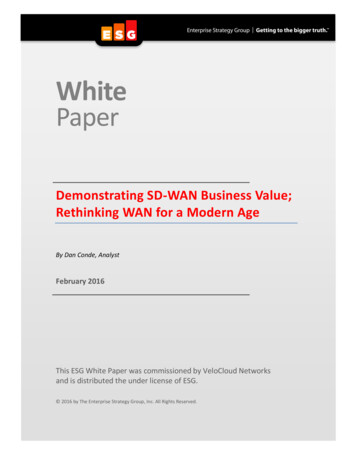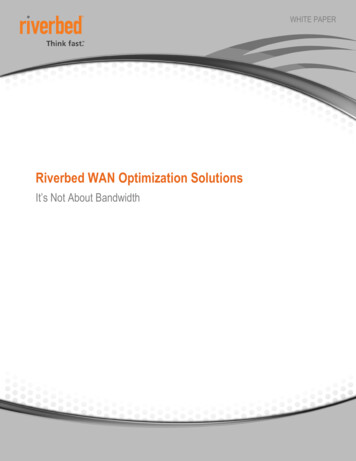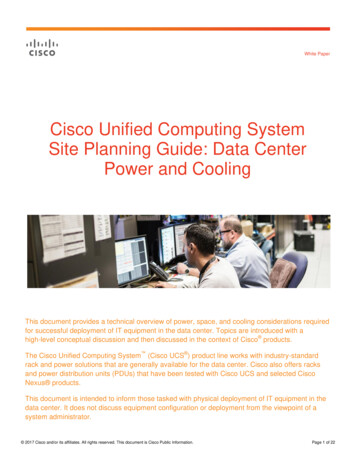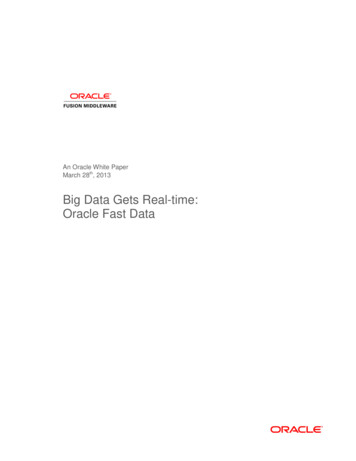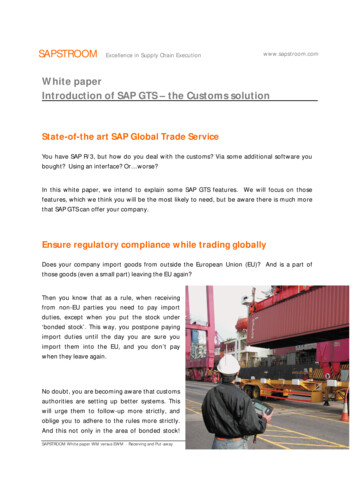
Transcription
White paper The Four Essential Pillars of Digital TransformationWhite PaperThe Four Essential Pillarsof Digital TransformationA practical blueprint for going digitalBy Dr. Ian Thomas and David RosewellPage 1 of 6enabling-digital.global.fujitsu.com
White paper The Four Essential Pillars of Digital TransformationIntroductionOver the past decade a new breed of digital company has emerged,quickening the tempo of business. Digital natives such as Spotify,AirBnB and Uber have delivered more convenient, responsive andengaging experiences for customers – and often disrupted entireindustry business models while doing so. As “digital natives” theirintrinsic use of digital technologies such as cloud, mobile and analyticsmeans that they continue to evolve and scale at speeds that areunthinkable for traditional organizations.The great digital gambleIt is no great insight to say that enterprises need to go digital - andrecent Fujitsu research has confirmed that most organizations nowhave a clear understanding of the potential benefits.Today the potential impacts of digitization extend beyond these digitalnatives and are a pressing issue for businesses spanning almost everyindustry. As more people, systems and things become inter-connected,so the scope to create new and novel digital value chains rapidlyincreases. Understanding the impact of these changes and successfullyevolving to avoid or exploit disruption is therefore critical to survival.But while there is a broad recognition of the dangers of inaction thereis also much confusion; a recent landmark survey by Fujitsu1 found thatFigure 1: Digital Tightrope Survey question: What do you think are thethis lack of clarity results in two in three digital projects beingmain benefits to digitalization within your organization?considered a gamble.C-level executives cited a number of roadblocks that were driving thisfeeling, such as a lack of alignment on digital priorities, difficultiesintegrating with existing infrastructure and processes and a perceivedlack of relevant skills. Together these issues have led to a broad rangeof digital disconnects - fragmented user experiences, disconnectedislands of process and data, a slow pace of change and a rise in siloscaused by shadow IT – all of which create further turmoil andundermine the end-to-end alignment required for success.But there is another way. In this paper we share our experiences ofworking with companies who are taking an outside-in approach totransformation, using customer experiences to drive alignment,integrating infrastructure and processes across the whole digitalenvironment and transforming IT practices to accelerate change andempower everyone in the organization to make things better.1 “Walkingthe digital tightrope, a Fujitsu report”, January 2016But our practical experience has also shown us that there is also noeasy path. Most existing businesses have been built and optimized fora pre-digital world and therefore find themselves weighed down bypre-digital technology investments, cultures and ways of working. Suchorganizations cannot merely flick a switch and become digitalovernight - or wait years for large, costly and high risk transformationprograms. They must achieve digital transformation using many quick,iterative steps – taking an evolutionary path that balances newcapabilities and old.But many enterprises take an unbalanced view of this evolution,addressing just one aspect of the necessary transformation – such ascreating new user experiences or introducing new developmentpractices. This fragmented approach results in a range of digitaldisconnects, with front-end customer experiences not connected withback-end systems, with development practices siloed between newand old systems or with business colleagues still frustrated and findingtheir own solutions beyond the four walls of the enterprise.Our expertsDr. Ian ThomasChief Marketing Officer, Fujitsu RunMyProcessIan Thomas is a Fujitsu strategist and thought leadercurrently serving as Chief Marketing Officer of FujitsuRunMyProcess. He also maintains a role as a StrategyDirector within Fujitsu’s Global Software Center.David RosewellHead of Strategy, Fujitsu Digital, EMEIADavid Rosewell helps organizations achieve theirbusiness outcomes in the digital world. His extensiveexperience in the IT industry spans businessdevelopment, consulting, and systems delivery acrossa variety of sectors including government, defense,utilities, retail and financial services.Page 2 of 6Figure 2: Potential outcomes of a disconnected approachto digitalizationenabling-digital.global.fujitsu.com
White paper The Four Essential Pillars of Digital TransformationThe practical outcome of these problems is an inability to knowwhether planned initiatives will actually make things better or createunforeseen new digital disconnects – leading to an overwhelmingfeeling that digital projects are simply a gamble.Unifying the user experienceTo ensure a joined-up digital strategy, it’s important to start with theneeds of your stakeholders and work inwards. Creating a consistent,connected experience for customers, citizens, employees and partners– one that supports people in achieving their business goals, whereverand however they happen to work – is the most important factor insatisfying peoples’ digital expectations. In particular creatingexperiences that help people get things done is a key weapon inattracting talent, maximizing employee productivity and retainingcustomers – three of the most popular aims cited by organizations inour digital research.Figure 3: Digital Tightrope Survey question: To what extent to youagree with the following statements on your organization’s digitalapproach? The success of the majority of digital projects in myorganization is a gamble.Improving the oddsBut not all organizations are trapped by the digital disconnect. Whenworking with enterprises who are successfully enabling digital changewe have observed a consistent set of behaviors which can begeneralized to create the foundations of a repeatable, evolutionaryapproach. In particular these organizations take an unashamedly endto-end approach that consists of four inter-connected pillars:But the consumer-focused approach of delivering individual apps is apoor template for the demands of enterprise mobility. Deliveringdigital experiences for the enterprise requires us to go beyondindividual apps and provide device and location-independent access tothe existing process and information infrastructure of the enterprise. Itis maximizing the mobility and connectedness of users that unlocksthe value of digital, not the devices themselves.True enterprise mobility therefore requires three major capabilities:All-round mobility A mobile application should not be tied to a single device type andshould seamlessly adapt to smartphones, tablets, wearables ordesktop PCs; it is the mobility of users that delivers the full benefit ofdigital processes, not the devices themselves.A common point of access People need a single, device independent location where they canfind and access all of the digital tools they need to interact with thebusiness; such an ‘enterprise process store’ of available applicationsensures ease of access, visibility of use and consistent governance.Figure 4: The four pillars of digital transformationTogether these four pillars combine to deliver a highly effectiveoutside-in approach to digital transformation.A 360 degree view of interactions As people increasingly work across multiple topics they need to gaina dynamic, 'at a glance' view across their ongoing tasks, replacingsiloed app-centric views with one which visualizes their total backlogof work holistically across all processes and systems.ExampleAt a major European public transport operator, a mobile incidentreporting app allows inspectors to file complete incident reportsfor bus lines from their phones in less than a minute, giving themaintenance team immediate access to details and photographs ofthe bus repairs required.Page 3 of 6enabling-digital.global.fujitsu.com
White paper The Four Essential Pillars of Digital TransformationConnecting digital processesDigital leaders have shown time and again that web-enabledconnections between people, systems and devices can transformbusiness models and create better outcomes. But many organizationsmiss the central role of end-to-end connectivity in this process, insteadfocusing only on the digital front-end. Simply creating ‘pixel thin’solutions via new apps or slicker websites, however, fails to addressthe underlying process and integration changes necessary tooptimize digital experiences, simply layering more complexity overexisting silos.Delivering at digital speedThe digital world will not wait for slow, incumbent developmentprocesses, technologies and applications to deliver change – to seizemarket opportunities, satisfy customer demands and innovate atdigital speed the enterprise has to be capable of delivering web scaleIT at a fundamentally different pace. Outward-facing teams must beable to constantly build and test new ways of interacting – fromexperiences, offerings and channels through to entirely new businessmodels – in order to discover and scale what works best.Creating a truly digital business therefore requires the creation of endto-end process flows which optimize the fulfilment of connectedexperiences. This requires an outside-in approach to transformation,reimagining outcomes before moving inwards connecting all of thepeople, software and things required to deliver the necessary value.And having the capability to constantly extend and evolve these‘digital supply chains’ as customers, partners and suppliers evolve isa critical skill for the digital age.Creating a truly digital business therefore begins with the use of digitalplatforms which support innovation at the new speed of business.By leveraging the increasing industrialization of IT we can createend-to-end modelling and deployment environments which increasespeed of delivery, connect to existing legacy systems and automaticallyhandle the deployment and scaling of systems to any size of audience:True process change therefore requires three major capabilities:Extending to digital On-premise systems still make up the critical transactional core ofmost enterprises and need to be quickly and easily connected to newdigital processes. This requires a combination of integrationconnectors, API management and manual workarounds to securelyand robustly connect incumbent systems to new digital flows.Harnessing digital Building end-to-end digital flows requires us to‘mesh’our internalsystems with people, systems and things that exist beyond thebounds of the organization. The technology infrastructure musttherefore connect the whole digital landscape, making on-demandresources an integral component of end-to-end business operations.Empowering ecosystems Competing in the emerging digital economy means participating inwider ecosystems with customers and partners. By using APIs toexpose your unique business Intellectual Property (IP) you can bringthe power of many organizations to bear on the task of realizing itsfull value.ExampleA major global utility has created a range of digital processes whichconnect their complex hybrid IT estate end-to-end. By usingintegration connectors to modify access rights across a range ofon-premise, partner and cloud systems these processes ensure thatdata remains secure as employees and external contractors join,change roles or leave the company.Page 4 of 6Rapid outcomes By using the cloud to integrate technology we can create digitalplatforms for high productivity business change. Such platformsenable enterprises to rapidly model and test new processes beforeimmediately rolling them out at scale to shorten release cycles.Multi-speed operation While new digital platforms can transform delivery speed, we stillneed to accommodate slower, mission critical IT. Our new platformsmust therefore provide the capability to decouple change cycles,quickly delivering new digital processes while maintainingconnections to back-end systems until they are upgraded or replaced.Delivering instant scale Development, integration and deployment is only the first step tobecoming digital. Many organizations overlook the challenges anddelays of scaling successful systems. Digital platforms enableorganizations to avoid delays by removing the need for hardwareand software procurement when there is increased demand.ExampleI HEART Studios, a rapidly expanding digital content provider basedin London, developed a digital process solution to automate andmanage its product photography services. In just twelve months thissolution enabled the company to grow its revenue by 600 percentand absorb a ten-fold increase in staff, all withoutsignificant disruption.enabling-digital.global.fujitsu.com
White paper The Four Essential Pillars of Digital TransformationEmpowering the organizationToday’s business talent is increasingly provided by digital natives whoexpect to be able to shape technology to their needs - but there is alsoa rapidly growing gap between a businesses’ appetite for digitalchange and the resources available to enterprise IT. Swamped bylegacy systems, siloed data and locked-down budgets CIOs are oftenforced to maintain the integrity of the company’s traditionalinformation systems at the expense of meeting its digital needs.This drives many business people to adopt ‘shadow IT’, creating hugepotential security and scalability headaches.Start small, learn fast and scale quicklyTaken together, the four pillars provide a structured foundation forcompleting an orderly, end-to-end digital transformation of theenterprise. It becomes possible to achieve large-scale change byworking in small increments, rapidly delivering digital innovations asearly as possible before quickly evolving them in both breadth anddepth. Together the ingredients form pa
of Digital Transformation . A practical blueprint for going digital By Dr. Ian Thomas and David Rosewell . White paper The Four Essential Pillars of Digital Transformation . Page 2 of 6 enabling-digital.global.fujitsu.com Introduction Over the past decade a new breed of digital company has emerged, quickening the tempo of business. Digital natives such as Spotify, AirBnB and Uber have .


